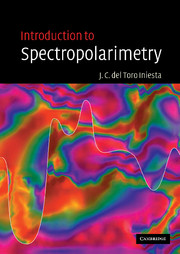Book contents
- Frontmatter
- Contents
- Preface
- Acknowledgements
- 1 Historical introduction
- 2 A review of some basic concepts
- 3 The polarization properties of quasi-monochromatic light
- 4 Linear optical systems acting on polarized light
- 5 Solar polarimetry
- 6 Absorption and dispersion
- 7 The radiative transfer equation
- 8 The RTE in the presence of a magnetic field
- 9 Solving the radiative transfer equation
- 10 Stokes spectrum diagnostics
- 11 Inversion of the RTE
- Index
4 - Linear optical systems acting on polarized light
Published online by Cambridge University Press: 11 August 2009
- Frontmatter
- Contents
- Preface
- Acknowledgements
- 1 Historical introduction
- 2 A review of some basic concepts
- 3 The polarization properties of quasi-monochromatic light
- 4 Linear optical systems acting on polarized light
- 5 Solar polarimetry
- 6 Absorption and dispersion
- 7 The radiative transfer equation
- 8 The RTE in the presence of a magnetic field
- 9 Solving the radiative transfer equation
- 10 Stokes spectrum diagnostics
- 11 Inversion of the RTE
- Index
Summary
Porque aquellas cosas que bien no son pensadas, aunque algunas veces hayan buen fin, comúnmente crían desvariados efectos. Así que la mucha especulación nunca carece de buen fruto.
—Fernando de Rojas, 1514.For those matters that are ill thought out may yet end well, even though they often breed strange consequences. Hence, much speculation never fails to bring forth some good fruit.
This chapter is aimed at understanding how nature and laboratory devices may change the polarization state of light. The transformations of the Stokes parameters are assumed to be linear, i.e., in terms of addition and multiplication by scalars. This is why we are restricted to linear optical systems. The qualifiers quasi-monochromatic and plane will be omitted from now on under the assumption that we are in fact dealing with this type of electromagnetic wave.
Propagation of light through anisotropic media
Changing the polarization state of light means modifying the coherency matrix elements, which in turn require that different components of the electric field vector are acted on differently by the medium. If Ex and Ey suffer the same alteration, a scaling of C is effected, so that the polarization state is unchanged. As a matter of fact, we have seen in the previous chapter how both the linear analyzer and the linear retarder act differently on given components of E. The wave equation (2.1), however, predicts no different behavior for the orthogonal components.
- Type
- Chapter
- Information
- Introduction to Spectropolarimetry , pp. 36 - 63Publisher: Cambridge University PressPrint publication year: 2003



